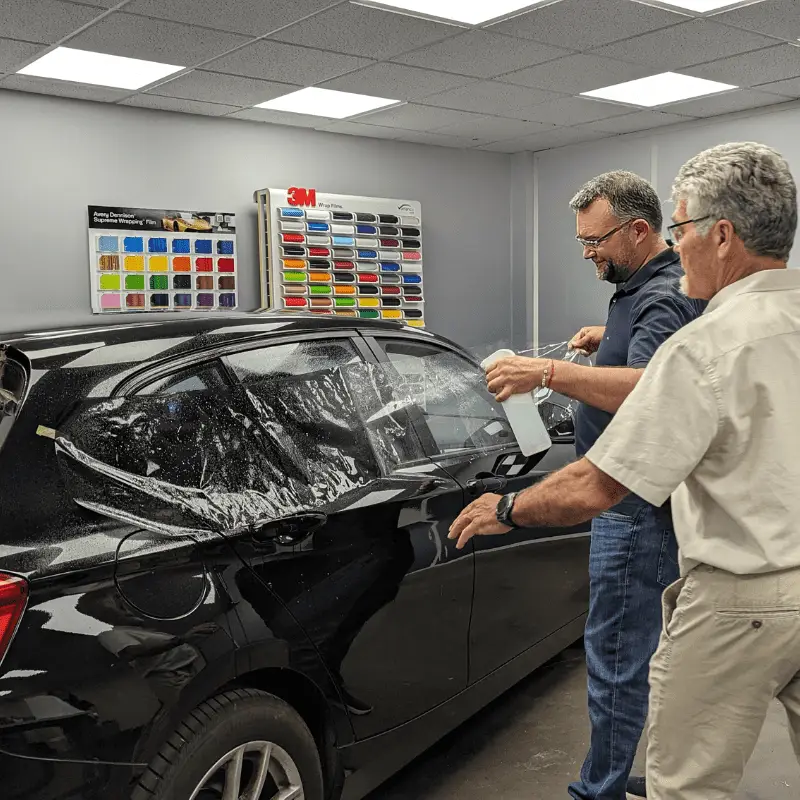
Le 30/07/2024
written by Laura P
What's the difference between electrostatic and adhesive solar film?
The differences between electrostatic and adhesive films
A tinted window kit, also known as solar film for cars, is ideal for giving your car a new look. There are two types of solar film on the market: electrostatic and adhesive. What are the differences? What are the advantages of each? We tell you all about it!

Difference 1: the film's appearance
From an aesthetic point of view, electrostatic or adhesive solar films offer a very different look due to their composition and thickness.
Adhesive solar film, on the other hand, is thinner and more transparent. So it's the best solution if you want to tint your car windows while retaining a natural look.
An electrostatic solar film, on the other hand, is thicker than its counterpart. As a result, it has an ocular texture. What's more, because of its thickness, it lets less light and brightness into the passenger compartment. This provides a higher level of privacy than adhesive solar film.
When choosing the tint of your solar protection film for your car, you need to identify your reasons for buying tinted windows. Tinted windows offer many advantages. Do you want to give your car a touch of originality? Or protect your car from the heat? Or to combat vandalism?
Once you've identified your reasons and desires, you can move on to the next step: choosing the right shade and the one that suits you best. At Variance Autowith our pre-cut and thermoformed films, you have a choice of four shades:
- The light black solar film lets in 36% of the light while rejecting 44% of the heat;
- The black solar film ensures 25% light penetration and 51% heat rejection;
- The dark black solar film lets 19% light and 46% heat into the cabin;
- The very dark black solar film has a light transmission of just 5% and rejects 64% of the sun's energy.
The less light electrostatic or adhesive solar film lets in, the greater its effectiveness against prying eyes.
You're probably wondering: is it legal to install a tinted solar film kit on a car? The answer is yes! In fact, according to Decree 2016-448:
- The vehicle's front windows must let in at least 70% of light:
- Rear windows are not subject to any particular law. Nevertheless, they must allow good visibility for all passengers and road users;
- On the other hand, the front and rear windscreens must never be tinted. This would reduce visibility, and therefore driving safety.

Difference 2: Film installation and removal
This is undoubtedly the most notable difference. The application of solar film for cars differs greatly between electrostatic and adhesive film.
The installation of an adhesive solar film must be meticulous. It's done with soapy water, and your glazing must be free of all dust, residues, grease and the like. This type of substance can cause wrinkles and bubbles, and damage the film and its durability. Once your glass is perfectly clean, you need to take your time applying the film. Once applied, it will be difficult to reposition, as its adhesion will be reduced and glue residues may form.
In contrast, electrostatic solar film is much easier to apply. The same installation and washing conditions apply. Because it's electrostatic, it adheres to glass without glue. As a result, it can be repositioned as often as required.
As for removal of a self-adhesive adhesive solar film, just like its installation, is more laborious. If your film has been in place for several years, you'll need to be patient. Nevertheless, using a scraper and a removal solution, you'll be able to remove the adhesive film.
Like installation, removal of electrostatic solar film is easy. Simply pull on the film. It will pull right off.

Difference 3: film durability
Depending on the reference chosen, installing a solar car film kit on a rear window or a side window will not have the same lifespan.
Adhesive solar film lasts from 5 to 15 years for the most resistant models.
In contrast, electrostatic solar film has a lifespan of around 2 years. Its shorter durability is due to its different composition from that of adhesive film. In addition, it is reusable and therefore handled more frequently.
You now have a clearer picture of the differences between electrostatic and adhesive solar films. All you have to do is make your choice.









